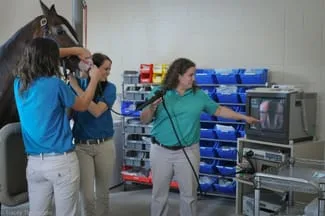
Reduce Your Horse’s Gastric Ulcer Risk
Ulcers are a man-made disease, affecting up to 90 percent of racehorses and 60 percent of
show horses. Stall confinement alone can lead to the development of ulcers. A horse’s
feeding schedule also can be a factor. When horses are fed just twice a day, the stomach
is subjected to a prolonged period without feed to neutralize its naturally produced acid.
In addition, high-grain diets produce volatile fatty acids that can also contribute to the
development of ulcers.
Stress, both environmental and physical, can increase the likelihood of ulcers, as can
hauling, training and mixing groups of horses. Strenuous exercise can decrease the
emptying of the stomach and the blood flow to the stomach, thus contributing to the
problem.
The treatment and prevention of gastric ulcers is directed at removing these predisposing
factors, thus decreasing acid production within the horse’s stomach. Follow these tips
from the American Association of Equine Practitioners (AAEP) to properly treat your
horse’s ulcers:
1. Allow free-choice access to grass or hay. Horses are designed to be grazers with
a regular intake of roughage.
2. If the horse must be stalled, arrange for the horse to see the horses he socializes
with. Consider offering a ball or other object that the horse can enjoy in his stall.
3. Feed the horse more frequently to help buffer the acid in the stomach.
4. Decrease grains that form volatile fatty acids.
5. Medications that decrease acid production are available, but are only necessary in
horses showing signs of clinical disease or when the predisposing factors, such as
stress, cannot be removed.
The prevention of ulcers is the key. Limiting stressful situations along with frequent
feeding or free-choice access to grass or hay is imperative. Neutralizing the production
of stomach acid is nature’s best antacid. For more information about gastric ulcers, ask
your equine veterinarian for the “Equine Gastric Ulcers” brochure provided by the
American Association of Equine Practitioners (AAEP) in association with Nutrena, an
AAEP Educational Partner. Additional information also can be found on the AAEP’s
website www.aaep.org/horseowner.
Permission for one-time use in printed media only is granted with attribution given to the
AAEP and Nutrena.
